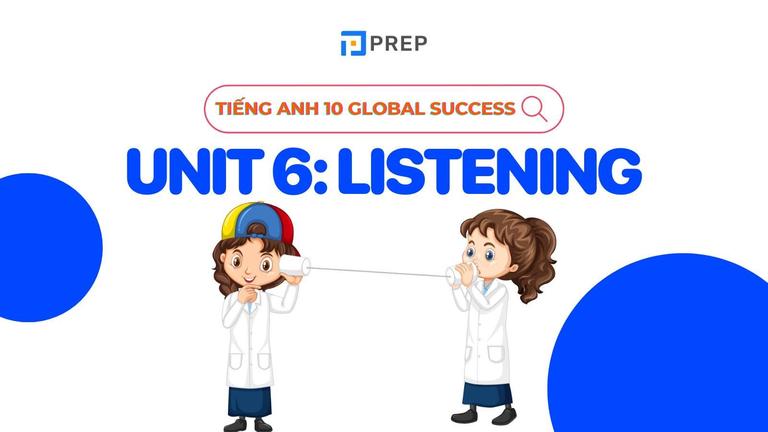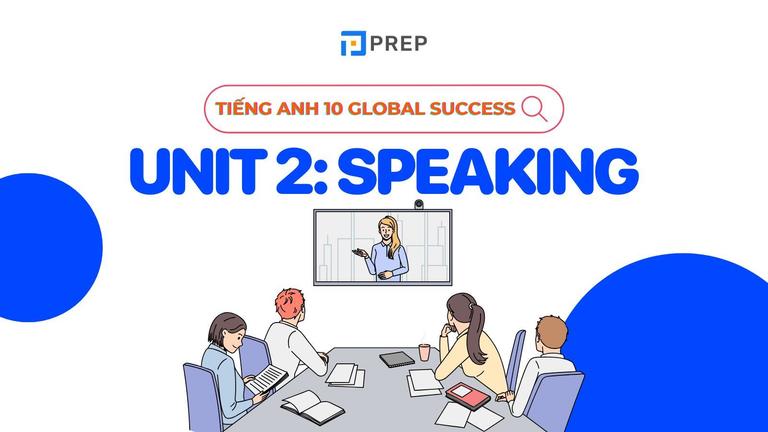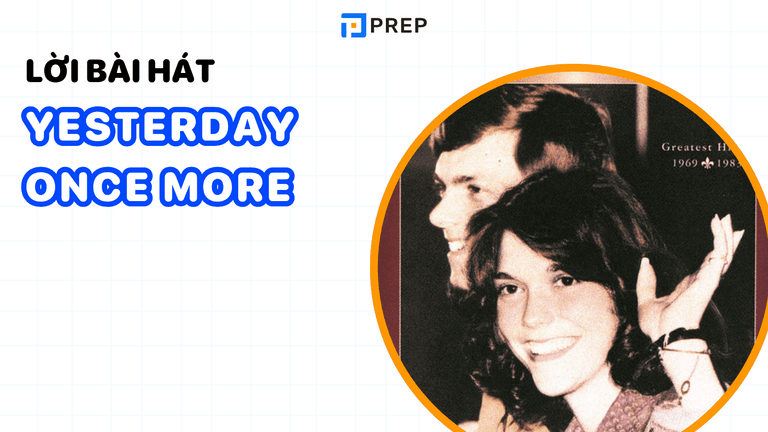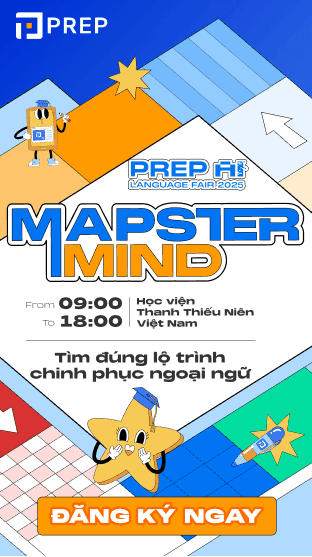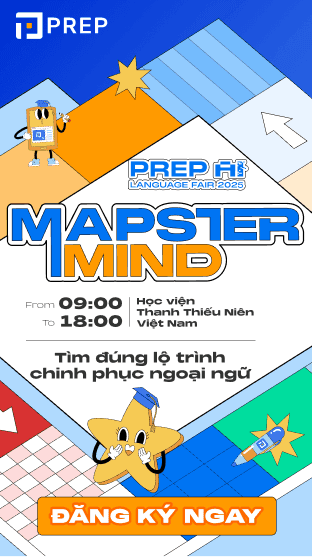Đề bài và giải thích đáp án IELTS Cambridge 13 Reading Test 3 passage 2 How baby talk gives infant brains a boost
Bài đọc How baby talk gives infant brains a boost trong IELTS Cambridge 13 Test 3 Passage 2 là bài đọc theo phong cách nghiên cứu khoa học, chứa nhiều thuật ngữ chuyên môn về ngôn ngữ học, thần kinh học và hành vi trẻ nhỏ. Trong bài viết này, chúng ta sẽ cùng xem đề bài, đáp án chuẩn, kèm giải thích chi tiết cho từng câu hỏi, giúp bạn hiểu rõ cách phát hiện thông tin, xử lý câu hỏi True/False/Not Given, Matching và chọn đáp án chính xác trong dạng bài học thuật của IELTS Reading nhé!
- I. Đề bài IELTS Cambridge 13 Reading Test 3 passage 2 How baby talk gives infant brains a boost
- II. Đáp án bài đọc Test 3 passage 2 How baby talk gives infant brains a boost
- III. Giải thích đáp án chi tiết bài đọc Test 3 passage 2 How baby talk gives infant brains a boost
- IV. Từ vựng hay trong bài cần ghi nhớ
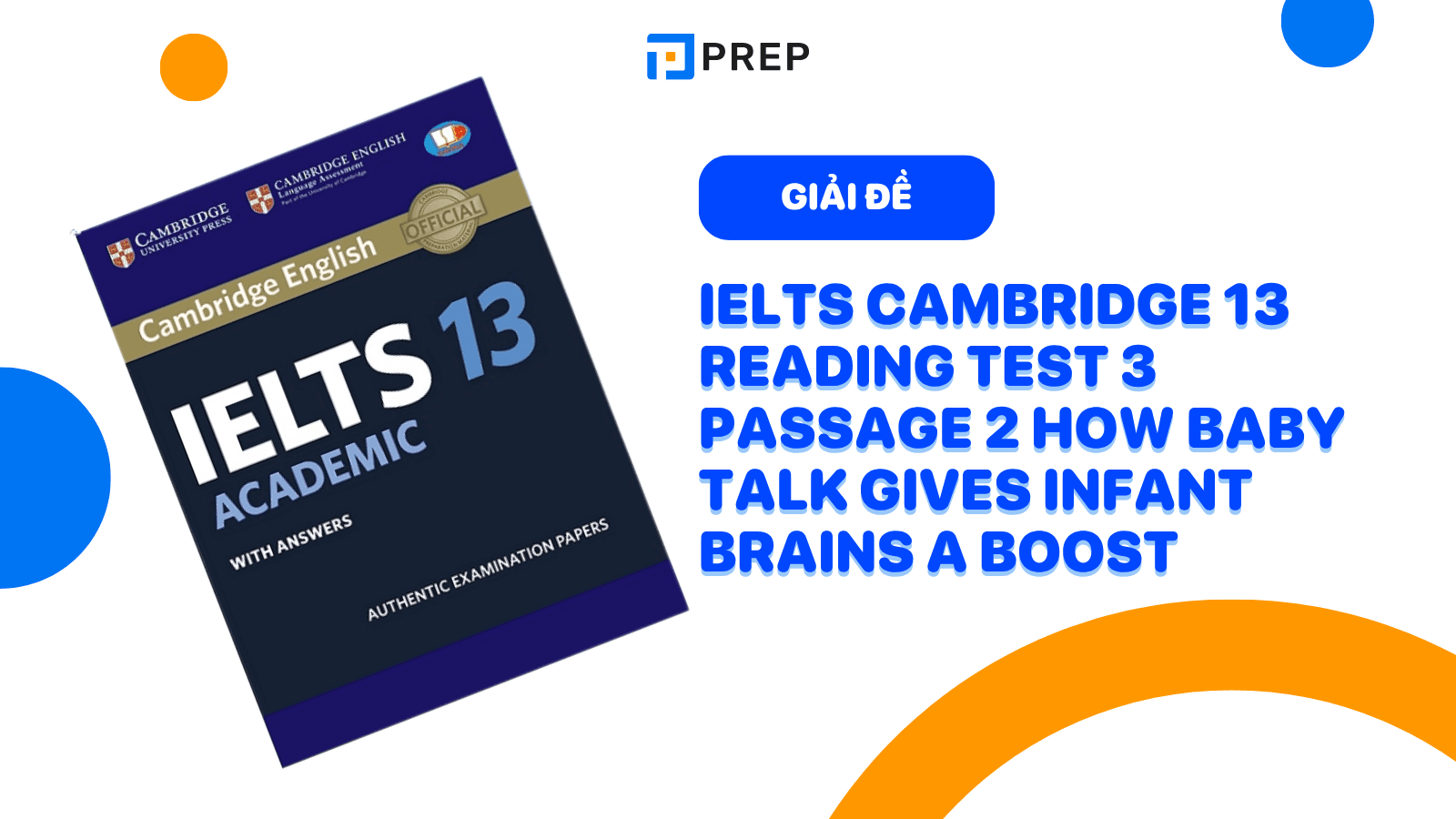
I. Đề bài IELTS Cambridge 13 Reading Test 3 passage 2 How baby talk gives infant brains a boost
Đọc kĩ đề bài và gạch chân các ý chính để trả lời câu hỏi nhé!
Reading How baby talk gives infant brains a boost
How baby talk gives infant brains a boost
A. The typical way of talking to a baby — high-pitched, exaggerated and repetitious — is a source of fascination for linguists who hope to understand how ‘baby talk’ impacts on learning. Most babies start developing their hearing while still in the womb, prompting some hopeful parents to play classical music to their pregnant bellies. Some research even suggests that infants are listening to adult speech as early as 10 weeks before being born, gathering the basic building blocks of their family’s native tongue.
B. Early language exposure seems to have benefits to the brain — for instance, studies suggest that babies raised in bilingual homes are better at learning how to mentally prioritize information. So how does the sweet if sometimes absurd sound of infant-directed speech influence a baby’s development? Here are some recent studies that explore the science behind baby talk.
C. Fathers don’t use baby talk as often or in the same ways as mothers — and that’s perfectly OK, according to a new study. Mark VanDam of Washington State University at Spokane and colleagues equipped parents with recording devices and speech-recognition software to study the way they interacted with their youngsters during a normal day. ‘We found that moms do exactly what you’d expect and what’s been described many times over,’ VanDam explains. ‘But we found that dads aren’t doing the same thing. Dads didn’t raise their pitch or fundamental frequency when they talked to kids.’ Their role may be rooted in what is called the bridge hypothesis, which dates back to 1975. It suggests that fathers use less familial language to provide their children with a bridge to the kind of speech they’ll hear in public. ‘The idea is that a kid gets to practice a certain kind of speech with mom and another kind of speech with dad, so the kid then has a wider repertoire of kinds of speech to practice,’ says VanDam.
D. Scientists from the University of Washington and the University of Connecticut collected thousands of 30-second conversations between parents and their babies, fitting 26 children with audio-recording vests that captured language and sound during a typical eight-hour day. The study found that the more baby talk parents used, the more their youngsters began to babble. And when researchers saw the same babies at age two, they found that frequent baby talk had dramatically boosted vocabulary, regardless of socioeconomic status. ‘Those children who listened to a lot of baby talk were talking more than the babies that listened to more adult talk or standard speech,' says Nairán Ramírez-Esparza of the University of Connecticut. 'We also found that it really matters whether you use baby talk in a one-on-one context,' she adds. 'The more parents use baby talk one-on-one, the more babies babble, and the more they babble, the more words they produce later in life.'
E. Another study suggests that parents might want to pair their youngsters up so they can babble more with their own kind. Researchers from McGill University and Université du Québec à Montréal found that babies seem to like listening to each other rather than to adults – which may be why baby talk is such a universal tool among parents. They played repeating vowel sounds made by a special synthesizing device that mimicked sounds made by either an adult woman or another baby. This way, only the impact of the auditory cues was observed. The team then measured how long each type of sound held the infants' attention. They found that the 'infant' sounds held babies' attention nearly 40 percent longer. The baby noises also induced more reactions in the listening infants, like smiling or lip moving, which approximates sound making. The team theorizes that this attraction to other infant sounds could help launch the learning process that leads to speech. 'It may be some property of the sound that is just drawing their attention,' says study co-author Linda Polka. 'Or maybe they are really interested in that particular type of sound because they are starting to focus on their own ability to make sounds. We are speculating here but it might catch their attention because they recognize it as a sound they could possibly make.'
F. In a study published in Proceedings of the National Academy of Sciences, a total of 57 babies from two slightly different age groups – seven months and eleven and a half months – were played a number of syllables from both their native language (English) and a non-native tongue (Spanish). The infants were placed in a brain- activation scanner that recorded activity in a brain region known to guide the motor movements that produce speech. The results suggest that listening to baby talk prompts infant brains to start practicing their language skills. 'Finding activation in motor areas of the brain when infants are simply listening is significant, because it means the baby brain is engaged in trying to talk back right from the start, and suggests that seven-month-olds' brains are already trying to figure out how to make the right movements that will produce words,' says co-author Patricia Kuhl. Another interesting finding was that while the seven-month-olds responded to all speech sounds regardless of language, the brains of the older infants worked harder at the motor activations of non-native sounds compared to native sounds. The study may have also uncovered a process by which babies recognize differences between their native language and other tongues.
Questions 14-17
Look at the following ideas (Questions 14-17) and the list of researchers below.
Match each idea with the correct researcher, A, B or C.
Write the correct letter, A, B or C, in boxes 14-17 on your answer sheet.
NB You may use any letter more than once.
-
the importance of adults giving babies individual attention when talking to them
-
the connection between what babies hear and their own efforts to create speech
-
the advantage for the baby of having two parents each speaking in a different way
-
the connection between the amount of baby talk babies hear and how much vocalising they do themselves
List of Researchers
A Mark VanDam
B Nairán Ramirez-Esparza
C Patricia Kuhl
Questions 18-23
Complete the summary below.
Choose NO MORE THAN TWO WORDS from the passage for each answer.
Write your answers in boxes 18-23 on your answer sheet.
Research into how parents talk to babies
Researchers at Washington State University used 18 _____________________, together with specialised computer programs, to analyse how parents interacted with their babies during a normal day. The study revealed that 19 _____________________ tended not to modify their ordinary speech patterns when interacting with their babies. According to an idea known as the 20 _____________________, they may use a more adult type of speech to prepare infants for the language they will hear outside the family home. According to the researchers, hearing baby talk from one parent and 'normal' language from the other expands the baby's 21 _____________________ of types of speech which they can practise.
Meanwhile, another study carried out by scientists from the University of Washington and the University of Connecticut recorded speech and sound using special 22 _____________________ that the babies were equipped with. When they studied the babies again at age two, they found that those who had heard a lot of baby talk in infancy had a much larger 23 _____________________ than those who had not.
Questions 24-26
Reading Passage 2 has six paragraphs, A-F.
Which paragraph contains the following information?
Write the correct letter, A-F, in boxes 24-26 on your answer sheet.
-
a reference to a change which occurs in babies' brain activity before the end of their first year
-
an example of what some parents do for their baby's benefit before birth
-
a mention of babies' preference for the sounds that other babies make
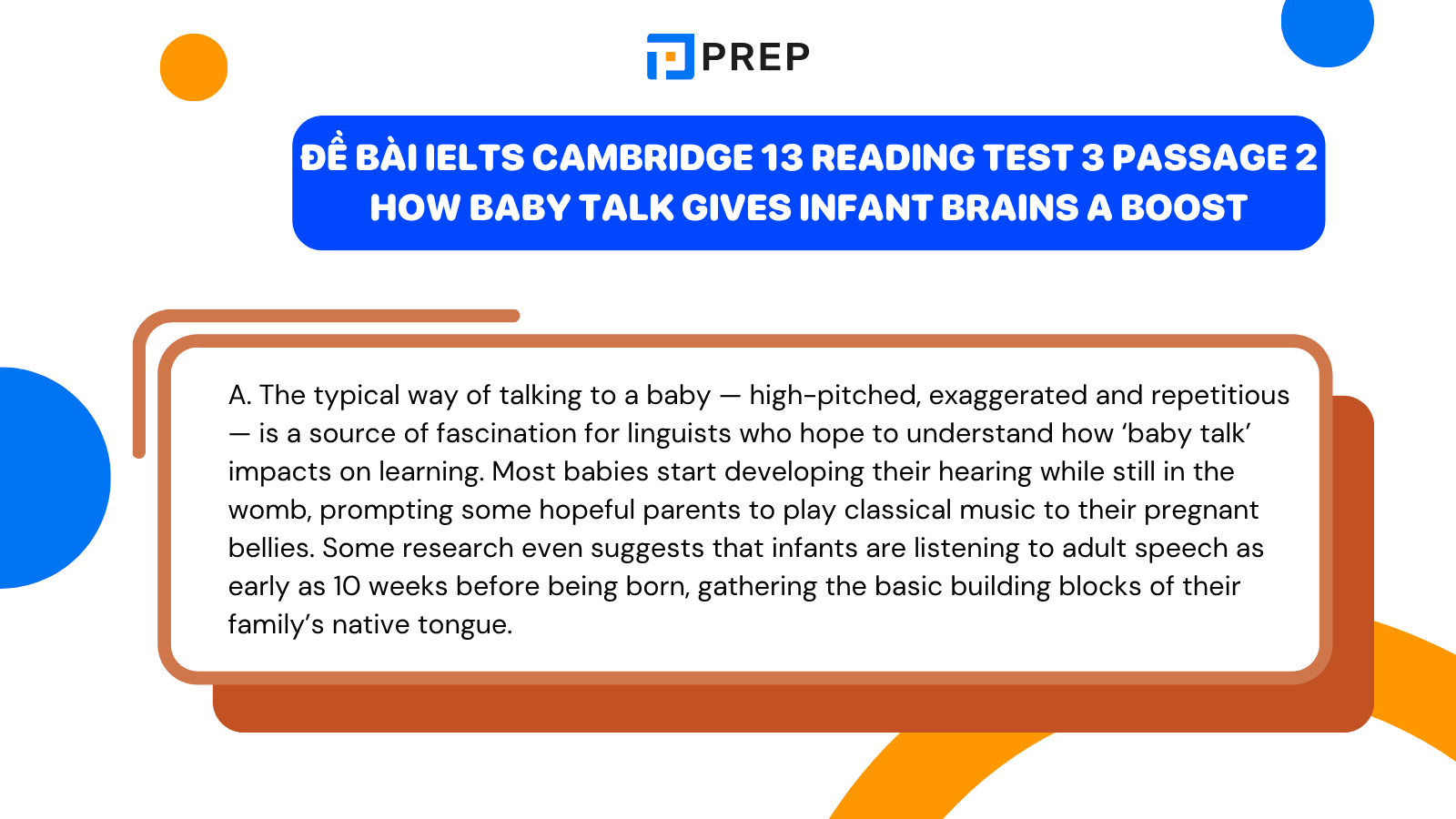
II. Đáp án bài đọc Test 3 passage 2 How baby talk gives infant brains a boost
Tham khảo đáp án bài đọc Test 3 passage 2 How baby talk gives infant brains a boost:
Reading Passage 2, Questions 14-26
-
B
-
C
-
A
-
B
-
recording devices
-
fathers / dads
-
bridge hypothesis
-
repertoire
-
(audio-recording) vests
-
vocabulary
-
F
-
A
-
E
III. Giải thích đáp án chi tiết bài đọc Test 3 passage 2 How baby talk gives infant brains a boost
Tham khảo phần giải thích đáp án chi tiết dưới đây để hiểu rõ cách giải quyết từng dạng câu hỏi:
A. Matching researchers (Questions 14–17)
|
Ý tưởng |
Đáp án |
Giải thích đáp án |
|
the importance of adults giving babies individual attention when talking to them |
B — Nairán Ramírez-Esparza |
Đoạn D: Ramírez-Esparza nói rõ “it really matters whether you use baby talk in a one-on-one context” — tức là việc nói chuyện riêng từng người với bé rất quan trọng. |
|
the connection between what babies hear and their own efforts to create speech |
C — Patricia Kuhl |
Đoạn F: Kuhl mô tả kết quả quét não (motor activation) cho thấy nghe thúc đẩy não bé chuẩn bị “nói lại” → liên hệ trực tiếp giữa âm thanh và cố gắng tạo âm thanh của trẻ. |
|
the advantage for the baby of having two parents each speaking in a different way |
A — Mark VanDam |
Đoạn C: VanDam mô tả bridge hypothesis — bố và mẹ dùng cách nói khác nhau, giúp trẻ có “wider repertoire” để luyện tập. |
|
the connection between the amount of baby talk babies hear and how much vocalising they do themselves |
B — Nairán Ramírez-Esparza |
Đoạn D: Ramírez-Esparza cho thấy the more parents use baby talk one-on-one, the more babies babble — nhiều baby talk → nhiều vocalising. |
B. Summary completion (Questions 18–23)
|
Số câu |
Đáp án |
Giải thích đáp án |
|
18 |
recording devices |
Đoạn C: VanDam & đồng nghiệp “equipped parents with recording devices and speech-recognition software…” |
|
19 |
fathers / dads |
Đoạn C: kết luận rằng “dads didn’t raise their pitch…” — bố hay cha không thay đổi cách nói nhiều. |
|
20 |
bridge hypothesis |
Đoạn C: tên giả thuyết nêu ra là bridge hypothesis (1975) để giải thích vai trò của bố. |
|
21 |
repertoire |
Đoạn C: VanDam nói trẻ có “a wider repertoire of kinds of speech to practice.” |
|
22 |
(audio-recording) vests |
Đoạn D: các nhà nghiên cứu “fitting 26 children with audio-recording vests that captured language and sound…” |
|
23 |
vocabulary |
Đoạn D: khi gặp lại ở tuổi hai, những bé nghe nhiều baby talk “had a much larger vocabulary.” |
(Lưu ý: đề yêu cầu NO MORE THAN TWO WORDS — ví dụ “recording devices” 2 từ; “audio-recording vests” có thể là “recording vests” tuỳ chỗ trống.)
C. Paragraph location (Questions 24–26)
|
Nội dung yêu cầu |
Đáp án |
Giải thích |
|
a reference to a change which occurs in babies' brain activity before the end of their first year |
F |
Đoạn F mô tả nghiên cứu với 7-month và 11½-month và khác biệt trong motor area activation — sự thay đổi trong não trước 1 tuổi. |
|
an example of what some parents do for their baby's benefit before birth |
A |
Đoạn A nói: một số cha mẹ “play classical music to their pregnant bellies” — ví dụ trước sinh. |
|
a mention of babies' preference for the sounds that other babies make |
E |
Đoạn E: nghiên cứu chỉ ra bé chú ý lâu hơn và phản ứng nhiều hơn với infant sounds → bé thích nghe tiếng trẻ con khác. |
Xem thêm: Đề bài và đáp án chi tiết IELTS Cambridge 13 Test 3 Passage 1 The coconut palm
IV. Từ vựng hay trong bài cần ghi nhớ
Take note nhanh một số từ vựng hay trong bài cần ghi nhớ dưới đây nhé!
|
Từ / Cụm từ |
Nghĩa |
Ví dụ |
|
baby talk / infant-directed speech / motherese |
cách người lớn nói với trẻ (giọng cao, lặp lại) |
Infant-directed speech helps babies learn language. → Cách nói dành cho trẻ giúp trẻ học ngôn ngữ. |
|
babble / vocalise |
bập bẹ, phát âm thử |
Babies who hear more baby talk tend to babble more. → Trẻ nghe nhiều baby talk thường bập bẹ nhiều hơn. |
|
repertoire |
tập loại (các kiểu) lời nói, khả năng biểu đạt |
A wider repertoire of speech gives babies more practice. → Có nhiều kiểu lời nói hơn giúp trẻ luyện tập nhiều hơn. |
|
bridge hypothesis |
giả thuyết cầu nối (vai trò của bố) |
The bridge hypothesis suggests dads provide a bridge to public speech. → Giả thuyết cầu nối cho rằng bố giúp trẻ làm quen với cách nói ngoài gia đình. |
|
recording device / audio-recording vest |
thiết bị ghi âm / áo ghi âm |
Researchers used recording devices to capture parent-baby interaction. → Các nhà nghiên cứu dùng thiết bị ghi âm để thu tương tác bố mẹ — trẻ. |
|
one-on-one |
một-một, riêng tư (1:1) |
One-on-one baby talk had a stronger effect on babbling. → Nói chuyện một-một tác động mạnh hơn tới bập bẹ. |
|
motor activation / motor areas |
vùng vận động (não) / kích hoạt vận động |
Motor activation shows babies' brains preparing speech movements. → Sự kích hoạt vùng vận động cho thấy não trẻ chuẩn bị chuyển động để “nói”. |
|
native / non-native |
(ngôn ngữ) bản địa / không bản địa |
Older infants showed different responses to native and non-native sounds. → Trẻ lớn hơn phản ứng khác với âm thanh ngôn ngữ bản địa và không bản địa. |
|
stimulus / auditory cue |
kích thích / tín hiệu thính giác |
Infant sounds served as an auditory stimulus that held attention. → Tiếng trẻ khác đóng vai trò kích thích thính giác giữ sự chú ý. |
|
synthesizing device |
thiết bị tổng hợp âm thanh |
They used a synthesizer to mimic infant and adult sounds. → Họ dùng thiết bị tổng hợp để nhái âm thanh trẻ và người lớn. |
|
socioeconomic status |
địa vị kinh tế-xã hội |
Vocabulary gains were found regardless of socioeconomic status. → Tăng vốn từ thấy ở mọi nhóm thu nhập. |
|
engaged / engagement |
thu hút, tham gia tích cực |
The baby brain is engaged in trying to talk back. → Não trẻ được kích hoạt để cố trả lời bằng âm thanh. |
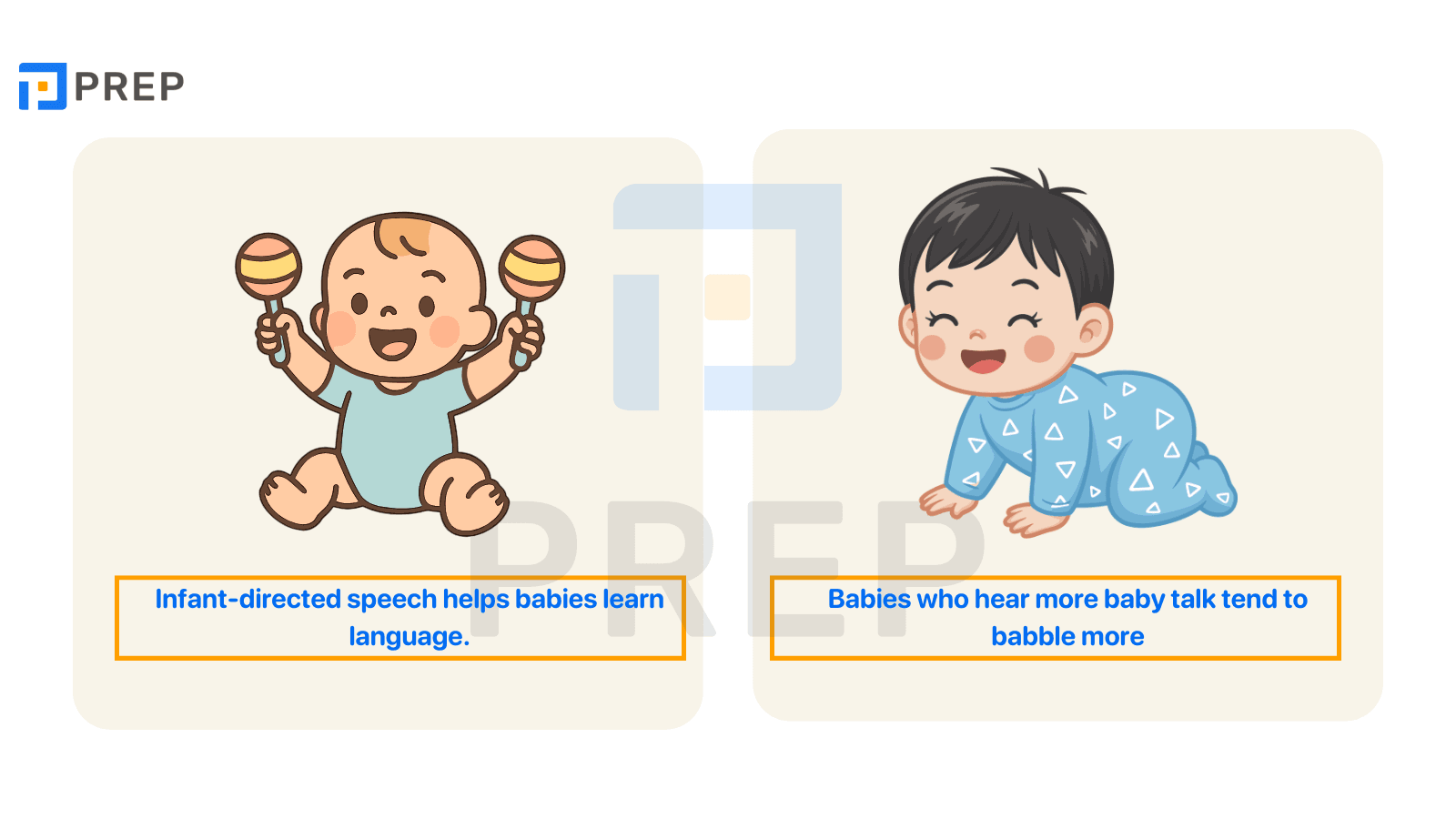
Mẹo nhỏ khi làm bài Reading:
-
Gạch từ khoá (names of researchers, study methods, age groups, thiết bị) — bài khoa học thường gắn chặt ý với tên người/đơn vị.
-
Với dạng matching researcher, đọc từng đoạn để tìm quan điểm chính gắn với tên đó, đừng đọc toàn bộ câu hỏi trước.
-
Với summary completion, chú ý số từ được phép và tìm phần bài có thuật ngữ tương ứng (ví dụ “recording devices”, “vocabulary”, “bridge hypothesis”).
-
Đối với paragraph identification, quét nhanh câu đầu/cuối của đoạn — thông tin cụ thể thường nằm ở đó.
Trên đây là đề bài và giải thích đáp án chi tiết bài đọc IELTS Cambridge 13 How baby talk gives infant brains a boost mà Prep đã biên soạn. Hy vọng tài liệu trên sẽ hữu ích cho bạn trong quá trình luyện thi IELTS.
Học tiếng Anh online dễ dàng hơn với PREP - Nền tảng Học & Luyện thi thông minh cùng AI. Nhờ công nghệ AI độc quyền, bạn có thể tự học trực tuyến ngay tại nhà, chinh phục lộ trình học IELTS, TOEIC, tiếng Anh giao tiếp hiệu quả. Bên cạnh đó, học viên còn có sự hỗ trợ tuyệt vời từ Teacher Bee AI, trợ lý ảo giúp bạn giải đáp thắc mắc và đồng hành 1-1 trong suốt quá trình học tập. Hãy click TẠI ĐÂY hoặc liên hệ HOTLINE 0931428899 để nhận tư vấn chi tiết về các khóa học tiếng Anh chất lượng nhất thị trường!
Tải ngay app PREP để bắt đầu hành trình học tiếng Anh tại nhà với chương trình học luyện thi online chất lượng cao.

Chào bạn! Mình là Hiền Hoàng, hiện đang đảm nhận vai trò quản trị nội dung sản phẩm tại Blog của website prepedu.com.
Với hơn 5 năm tự học các ngoại ngữ như tiếng Anh, tiếng Trung và ôn luyện một số kỳ thi IELTS, TOEIC, HSK, mình đã tự đúc rút được nhiều kinh nghiệm để hỗ trợ hàng nghìn người đang gặp khó khăn trong việc học ngoại ngữ. Hy vọng rằng những chia sẻ phía trên sẽ giúp ích cho bạn trong quá trình tự ôn luyện thi hiệu quả tại nhà!
Bình luận
Nội dung premium
Xem tất cảLộ trình cá nhân hoá
Có thể bạn quan tâm
Kết nối với Prep

MSDN: 0109817671.
Địa chỉ liên hệ: Tòa nhà Vinaconex, 34 Láng Hạ, phường Láng, TP Hà Nội.
Địa chỉ kinh doanh: Lô 21 C2 Khu đô thị Nam Trung Yên, phường Yên Hòa, TP Hà Nội.
Trụ sở: Số nhà 20, ngách 234/35 đường Hoàng Quốc Việt, phường Nghĩa Đô, TP Hà Nội.
Phòng luyện ảo - Trải nghiệm thực tế - Công nghệ hàng đầu.
Hotline: 0931 42 8899.
Trụ sở: Số nhà 20, ngách 234/35 đường Hoàng Quốc Việt, phường Nghĩa Đô, TP Hà Nội.
Giấy chứng nhận hoạt động đào tạo, bồi dưỡng số 1309/QĐ-SGDĐT ngày 31 tháng 07 năm 2023 do Sở Giáo dục và Đào tạo Hà Nội cấp.
